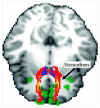Structural connectivity of neural reward networks in youth at risk for substance use disorders
- PMID: 25563237
- PMCID: PMC4465865
- DOI: 10.1007/s00213-014-3857-y
Structural connectivity of neural reward networks in youth at risk for substance use disorders
Abstract
Background: Having a positive family history of alcohol use disorders (FHP), as well as aberrant reward circuitry, has been implicated in the initiation of substance use during adolescence. This study explored the relationship between FHP status and reward circuitry in substance naïve youth to better understand future risky behaviors.
Methods: Participants were 49 FHP and 45 demographically matched family history negative (FHN) substance-naïve 12-14 year-olds (54 % female). Subjects underwent structural magnetic resonance imaging, including diffusion tensor imaging. Nucleus accumbens and orbitofrontal cortex volumes were derived using FreeSurfer, and FSL probabilistic tractography probed structural connectivity and differences in white matter diffusivity estimates (e.g. fractional anisotropy, and mean, radial, and axial diffusivity) between fiber tracts connecting these regions.
Result: FHP and FHN youth did not differ on nucleus accumbens or orbitofrontal cortex volumes, white matter tract volumes, or percentages of streamlines (a proxy for fiber tract count) connecting these regions. However, within white matter tracts connecting the nucleus accumbens to the orbitofrontal cortex, FHP youth had significantly lower mean and radial diffusivity (ps < 0.03) than FHN youth.
Discussion: While white matter macrostructure between salience and reward regions did not differ between FHP and FHN youth, FHP youth showed greater white matter coherence within these tracts than FHN youth. Aberrant connectivity between reward regions in FHP youth could be linked to an increased risk for substance use initiation.
Keywords: Adolescence; Cognitive control; Diffusion tensor imaging (DTI); Family history of alcohol use disorders; Nucleus accumbens; Orbitofrontal cortex; Probabilistic tractography; Reward circuitry; Structural connectivity; Substance use disorders; White matter integrity.
Figures


Similar articles
-
White matter integrity in alcohol-naive youth with a family history of alcohol use disorders.Psychol Med. 2014 Oct;44(13):2775-86. doi: 10.1017/S0033291714000609. Epub 2014 Mar 24. Psychol Med. 2014. PMID: 25066702 Free PMC article.
-
Neurobiological phenotypes associated with a family history of alcoholism.Drug Alcohol Depend. 2016 Jan 1;158:8-21. doi: 10.1016/j.drugalcdep.2015.10.021. Epub 2015 Oct 21. Drug Alcohol Depend. 2016. PMID: 26559000 Free PMC article. Review.
-
Risky decision-making: an FMRI study of youth at high risk for alcoholism.Alcohol Clin Exp Res. 2012 Apr;36(4):604-15. doi: 10.1111/j.1530-0277.2011.01650.x. Epub 2012 Jan 17. Alcohol Clin Exp Res. 2012. PMID: 22250647 Free PMC article.
-
Resting state functional connectivity of the nucleus accumbens in youth with a family history of alcoholism.Psychiatry Res. 2014 Mar 30;221(3):210-9. doi: 10.1016/j.pscychresns.2013.12.004. Epub 2013 Dec 24. Psychiatry Res. 2014. PMID: 24440571 Free PMC article.
-
Structural connectivity in Parkinson's disease.Parkinsonism Relat Disord. 2016 Jan;22 Suppl 1:S56-9. doi: 10.1016/j.parkreldis.2015.09.018. Epub 2015 Sep 14. Parkinsonism Relat Disord. 2016. PMID: 26394678 Review.
Cited by
-
Alcoholism and sexual dimorphism in the middle longitudinal fascicle: a pilot study.Brain Imaging Behav. 2017 Aug;11(4):1006-1017. doi: 10.1007/s11682-016-9579-5. Brain Imaging Behav. 2017. PMID: 27448160 Free PMC article.
-
Associations Between Family History of Alcohol and/or Substance Use Problems and Frontal Cortical Development From 9 to 13 Years of Age: A Longitudinal Analysis of the ABCD Study.Biol Psychiatry Glob Open Sci. 2023 Dec 19;4(2):100284. doi: 10.1016/j.bpsgos.2023.100284. eCollection 2024 Mar. Biol Psychiatry Glob Open Sci. 2023. PMID: 38312852 Free PMC article.
-
Chronic Stress in Adolescents and Its Neurobiological and Psychopathological Consequences: An RDoC Perspective.Chronic Stress (Thousand Oaks). 2017 Jan-Dec;1:2470547017715645. doi: 10.1177/2470547017715645. Epub 2017 Jun 18. Chronic Stress (Thousand Oaks). 2017. PMID: 29527590 Free PMC article.
-
White matter integrity in the fronto-striatal accumbofrontal tract predicts impulsivity.Brain Imaging Behav. 2018 Oct;12(5):1524-1528. doi: 10.1007/s11682-017-9820-x. Brain Imaging Behav. 2018. PMID: 29302916 Free PMC article.
-
Adolescent alcohol exposure decreases frontostriatal resting-state functional connectivity in adulthood.Addict Biol. 2018 Mar;23(2):810-823. doi: 10.1111/adb.12530. Epub 2017 Jul 9. Addict Biol. 2018. PMID: 28691248 Free PMC article.
References
-
- Achenbach TM, Rescorla LA. Manual for the ASEBA School-Age Forms & Profiles. University of Vermont, Research Center for Children, Youth, & Families; Burlington, VT: 2001.
-
- American Psychiatric Association . Diagnostic and statistical manual of mental disorders. 4th edition. American Psychiatric Association; Washington, DC: 1994. (DSM-IV)
-
- Andersson JL, Skare S. A model-based method for retrospective correction of geometric distortions in diffusion-weighted EPI. Neuroimage. 2002;16:177–199. - PubMed
-
- Andreasen NC, Rice J, Endicott J, Reich T, Coryell W. The family history approach to diagnosis. How useful is it?. Arch Gen Psychiatry. 1986;43:421–429. - PubMed
-
- Basser PJ, Pierpaoli C. Microstructural and physiological features of tissues elucidated by quantitative-diffusion-tensor MRI. J Magn Reson B. 1996;111:209–219. - PubMed
Publication types
MeSH terms
Grants and funding
LinkOut - more resources
Full Text Sources
Other Literature Sources

